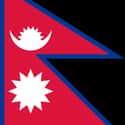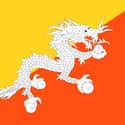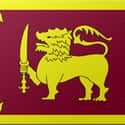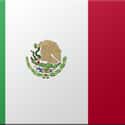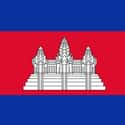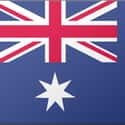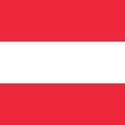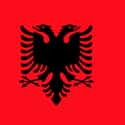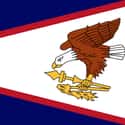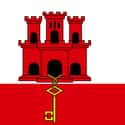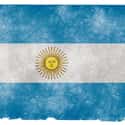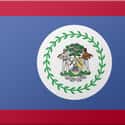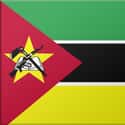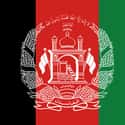-
(#1) Nepal
Nepal posseses the only flag in the world that doesn't conform to a rectangular shape. The Nepalese flag is made of two overlapping triangular pendants, which may represent the peaks of the Himalayas. The red coloring of the flag is the same shade as Nepal's national flower, the rhododendron, and is outlined in blue, which represents harmony.
There are varying explanations for Nepal's uniquely-shaped flag. The government's official position is that, instead of mountains, the two triangles represent the nation's two primary religions, Hinduism and Buddhism. The crescent moon in the upper triangle stands for both tranquility and the cool shade in the shadow of the country's enormous mountains, while the sun represents the heat of the lowland parts of Nepal. The sun and moon are also supposed to stand for the nation's aspirations toward longevity, or the desire to exist as long as the moon and the sun themselves.
-
(#2) Bhutan
- Thimphu
This flag features a yellow and orange background divided in half diagonally, and a giant thunder dragon known as a Druk, which is a major part of Bhutanese mythology. The Druk is entirely white, symbolizing purity, and clutches a norbu (or a jewel believed to have magical wish-fulfilling properties) in each claw as a metaphor for the nation's wealth.
The background colors symbolize the two forces in the lives of the Bhutanese, with orange representing the Buddhist spiritual tradition of the nation and the yellow honoring the authority of the ruling dynasty and the Dragon King of Bhutan.
-
(#3) Sri Lanka
Not many flags depict a lion who can straight up end you. For the flag of Sri Lanka, the saber-wielding lion represents the Sinhalese people and the bravery and strength of the nation's population. Meanwhile, the blade itself represents the country's sovereignty and willingness to fight for its independence.
The panel featuring the lion includes four bo leaves from the sacred fig tree. The bo leaves represent the role Buddhism plays in the lives of the people of Sri Lanka, specifically the four Buddhist virtues: kindness, happiness, friendliness, and equanimity.
The colors of Sri Lanka's flag directly honor the major ethnic groups of the country. Orange represents the Sri Lankan Tamils and green symbolizes the Sri Lankan Moors. Maroon, which provides the backdrop to the massive lion, represents the Sinhalese majority. Even those who belong to other groups are respected, as the yellow border is meant to honor all other peoples with diverse ethnic backgrounds.
-
(#4) Mexico
Americans may be familiar with Mexico's green, white and red flag, but many may not realize the eagle in the middle is actually eating a snake. The image, from Mexico's coat of arms, pays tribute to an Aztec legend. As the story goes, the wandering Aztec people were told to settle where they witnessed an eagle feasting on a writhing snake while sitting atop a cactus. The nomadic Aztecs supposedly saw this happen in the place where they founded Tenochtitlan, which is now Mexico City.
The colors of the flag hold great significance to the country. Green symbolizes hope, in the form of its fertile soile; white is for purity and the Roman Catholic religion; and red represents the blood shed for the nation's independence.
-
(#5) Cambodia
- Phnom Penh
The Cambodian flag features two blue horizontal bands at the top and bottom, with a red band running across the center. The center of the banner features Angkor Wat, an ancient temple in Cambodia that is one of the largest religious monuments in the world.
This is the only flag in the world that depicts an actual real-world building, which shows how important Angkor Wat is to the country's culture and history.
-
(#6) Australia
The Union Jack of the United Kingdom appears in the top left quadrant of the Australian flag. Directly below it is a large, seven-pointed star known as the Commonwealth Star, which takes up the lower left quadrant. Each point on the stylized star represents the six original states that make up the nation, as well as one additional point for all of Australia's territories. The right half of the flag uses four Commonwealth stars, and one five-pointed star, to depict the Southern Cross constellation, which can be seen in the night sky across the continent.
The Union Jack, which serves as a flag within this flag, is complex in its own right. The crossed stripes are a blend of three other flags: the red cross of St. George for England, the diagonal cross of St. Patrick for Ireland, and the diagonal white cross of St. Andrew for Scotland.
-
(#7) Austria
While Austria's flag may not appear to be particularly unique, it's modeled after a piece of blood-drenched clothing. The flag, possibly one of the oldest national flags still in use, features two red horizontal bands at the top and bottom, with a band of white across the center. According to Austrian legend, the design is modeled on the tunic of Duke Leopold V following a violent battle during the third crusade. His white shirt soaked in gore, Leopold removed his belt to reveal a band of unstained fabric beneath.
Though possibly fictional, the story has served as the inspiration for Austria's red and white flag for over 800 years.
-
(#8) Albania
While the Albanian flag might not contain as many colors or symbols as some of the other flags on this list, its bold choice of a blood-red background and a black, double-headed eagle make it stand out in a crowded field of bright hues and complex crests. The stark double-headed eagle is said to be the heraldic symbol used by the Albanian folk hero and warrior Skanderbeg, who led a violent rebellion against the Ottoman Empire. The revolt successfully (albeit temporarily) gained independence for the Albanians in the mid-1400s.
There is also a folkloric belief that Albanians are descendants of eagles, and the populace sometimes refer to themselves as Shqiptar, which translates to "Sons of the Eagle."
-
(#9) Isle of Man
This flag depicts three armored legs joined at the thigh and arranged in a circle. Based on the Celtic sun symbol known as the triskelion, the image is referred to as the Legs of Man. It is based on the coat of arms of the Norse King of Mann, a royal title held by multiple rulers between 1200 and 1500.
While it's unknown exactly how the Legs of Man came to represent the king on his coat of arms, they were adopted to represent the Isle of Man on the nation's flag in 1932. Before then, the country only used the Union Jack as a member of the British commonwealth. To this day, the Isle of Man's flag is still required to fly lower on the mast than the Union Jack.
-
(#10) American Samoa
The Samoan Islands were settled an estimated 2,000 years ago by Polynesian explorers. Fast-forward to the late 19th century when the colonial powers of the age were breaking the islands up into spheres of influence. The United States and Germany divided the islands between themselves in 1899, with American Samoa remaining an unincorporated territory to this day.
Until 1960, American Samoa flew the traditional Stars and Stripes. In creating its own flag, the territory looked to evoke American symbolism with its use of red, white and blue, and the inclusion of the American bald eagle. In a spin on the Great Seal of the United States, the flag's eagle holds in its talons two Samoan symbols of power: a battle club known as a fa'alaufa'i and a coconut fiber fly-whisk called a fue. These are supposed to represent America's guardianship over the territory.
-
(#11) Gibraltar
This white and red flag is dedicated to Gibraltar's historical role in international diplomacy and conquest. The image on the flag depicts a red castle, which symbolizes Gibraltar's fortress-like geography and honors the massive limestone ridge known as the Rock of Gibraltar. The golden key below it represents the nation's strategic importance as the metaphorical key to the Mediterranean.
The image also serves as Gibraltar's coat of arms, which was granted to the country by King Ferdinand and Queen Isabella of Spain in 1502.
-
(#12) Argentina
The Argentinian flag features two light blue bands of color with a band of white in the middle. The design is said to represent the clear blue skies and snow-covered peaks of the Andes. In the center of the flag is a sun with a human face. This image represents the Incan sun god, Inti, and pays tribute to the country's rich cultural heritage. It is also known as the "Sun of May," in honor of an event that took place on May 25, 1810. During a gathering of protesters demanding independence, the sun broke through the clouds.
-
(#13) Belize
The flag of Belize features a blue background with thin red bands on the top and bottom edges, as well as the country's coat of arms. The coat features a circle of mahogany leaves, a shield, and two men standing beside a mahogany tree. The imagery honors the country's rich logging industry, which lead the English to settle there.
The motto inscribed on the coat of arms reads, "Sub Umbra Floreo," or, "I flourish in the shade." This is the only national flag that depicts human beings.
-
(#14) Mozambique
This southern African nation has the distinction of being one of only two countries in the world with a gun on its flag (along with Guatemala). There is a lot going on in Mozambique's flag. In the triangular section on the left side of the flag, there is an AK-47 that represents resistance, independence and the country's willingness to defend its sovereignty by force. The AK is crossed with a gardening hoe, which represents the nation's agriculture. They are both above a book, symbolizing the importance of education. Those symbols all rest over a yellow star, which represents the ideals of Marxism and the nation's support for internationalism.
Five colors represent specific aspects of the country itself. The green band represents the natural riches of the country's land, the thin white bands are symbolic of peace and freedom, the black band honors the continent of Africa, the thick yellow band pays tribute to the country's mineral resources, and the red panel represents Mozambique's bloody struggle for independence.
-
(#15) Afghanistan
- Kabul
Despite undergoing more changes in the last century than any other flag in the world, the flag of Afghanistan has maintained its black, red, and green color scheme for each iteration. The most recent version features a central image, drawn in white, of a mosque flanked by flags and encircled by sheaves of wheat. The image represents the nation's primary religion, Islam, and its agricultural heritage.
The flag celebrates the country's sovereignty with the numerals for the solar Islamic calendar year 1298 written below the mosque. This corresponds to 1919 in the Gregorian calendar - the year that Afghanistan gained independence from British control. The other messages in the central image include the Shahada, the Islamic creed, and the Arabic expression, "God Is Great." The name of the country is also spelled out in Arabic on a scroll below the mosque.
New Random Displays Display All By Ranking
About This Tool
Each country’s national flag has its unique and undisputed images and colors with cultural characteristics. The duty of any national flag is to pay tribute to the history and culture it represents. These specially designed flags show the rich and interesting characteristics of their respective countries. There are various explanations for the flag of each country. For example, Nepal has the only flag in the world that is not rectangular. The flag of Nepal is composed of two overlapping triangles, possibly representing the peaks of the Himalayas.
Do you remember any special countries' unique flags? Our random tool would introduce some surprising meanings of them, welcome to check the interesting collection and share this tool with friends.
Our data comes from Ranker, If you want to participate in the ranking of items displayed on this page, please click here.

